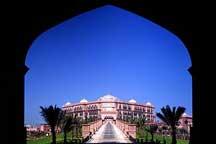 May. 2, 2025
May. 2, 2025
Weather
Warming threatens aquatic resources on Qinghai-Tibet Plateau
2009-09-27 15:24 BJT

Swans play on a lake in the Guomangtan Nature Reserve, northeastern Qinghai-Tibet Plateau. (Xinhua Photo)
BEIJING, Sept. 15 -- The Qinghai-Tibet Plateau is one of the regions hardest hit by global warming, which will have direct and long-term effects on the aquatic animals living in this area, said Wang Ding, a veteran expert from the Institute of Hydro Biology (IHB) under the Chinese Academy of Sciences (CAS).
Hard-hit plateau
Statistics show that the temperature in the Tibet Autonomous Region rose by an average of 0.32 Degrees Centigrade every 10 years between 1961 and 2008.
That rate of warming was much faster than the average across China, where temperatures rose by between 0.05 and 0.08 Degrees Centigrade every 10 years during that period.
The situation is similar in neighboring Qinghai Province.
The rising temperatures have led to the continuous melting of glaciers, scientists have found.
After the Arctic and Antarctic, the Qinghai-Tibet Plateau has the third-largest number of glaciers.
But 82 percent of glacier surfaces on the plateau have retreated, and the glacier area itself has decreased by 4.5 percent during the past 20 years, according to Qin Dahe from CAS.

Photo shows a scenery on the Qinghai-Tibet Plateau. The Qinghai-Tibet Plateau is one of the regions hardest hit by global warming, which will have direct and long-term effects on the aquatic animals living in this area. (Xinhua Photo)
Qin is the former head of the China Meteorological Administration, and he is former co-chair of a working group for the Intergovernmental Panel on Climate Change.
"Due to global warming, glaciers on the Qinghai-Tibet Plateau are retreating extensively at a speed faster than in any other part of the world," Qin said.
"In the short term, this will cause lakes to expand and bring floods and mudflows," Qin said.
Another threat from warming is the degradation of permafrost, or perennially frozen ground, Qin said.
"Permafrost plays a vital role in protecting the ecological environment and hydrological cycles. But it has been breaking down during the past 50 years," Qin said.
All these events could mean catastrophic changes for the aquatic animals in the Qinghai-Tibet plateau, as they are very fragile to any slight alteration of habitats, according to Chen of IHB.
Upsetting the balance
"Changes of topography and river directions are common in the Qinghai-Tibet plateau," Chen said.
"But the wetland degradation as a result of warming may threaten the fate of aquatic life," he said.
Introducing new species forced upstream also might lead to upsetting the ecological balance in the river sources.
"The result is still hard to predict at the moment," Chen said.
The survey was jointly conducted by the World Wildlife Fund, IHB, Yangtze River Fishery Resources Management Committee and the Qinghai Provincial Fishery Environment Monitoring Center.
This is the first time that Chinese scientists have conducted a thorough survey of fish resources in the source regions of the Yangtze, said Wang Limin, deputy conservation director of the World Wildlife Fund.
"This survey will help to give us a panoramic view of the fishery resources in the source regions of the Yangtze, and help us understand the impact of climate change on aquatic life in the river," Wang said.
"The Yangtze River is facing different challenges posed by global warming at different river sections," she said, "Knowing what is happening in the source regions will help us better mitigate and adapt to the changes."
Editor: 卢佳颖 | Source: China Daily
 Mail
Mail Share
Share Print
Print


 Video
Video









 2009 China Central Television. All Rights Reserved
2009 China Central Television. All Rights Reserved